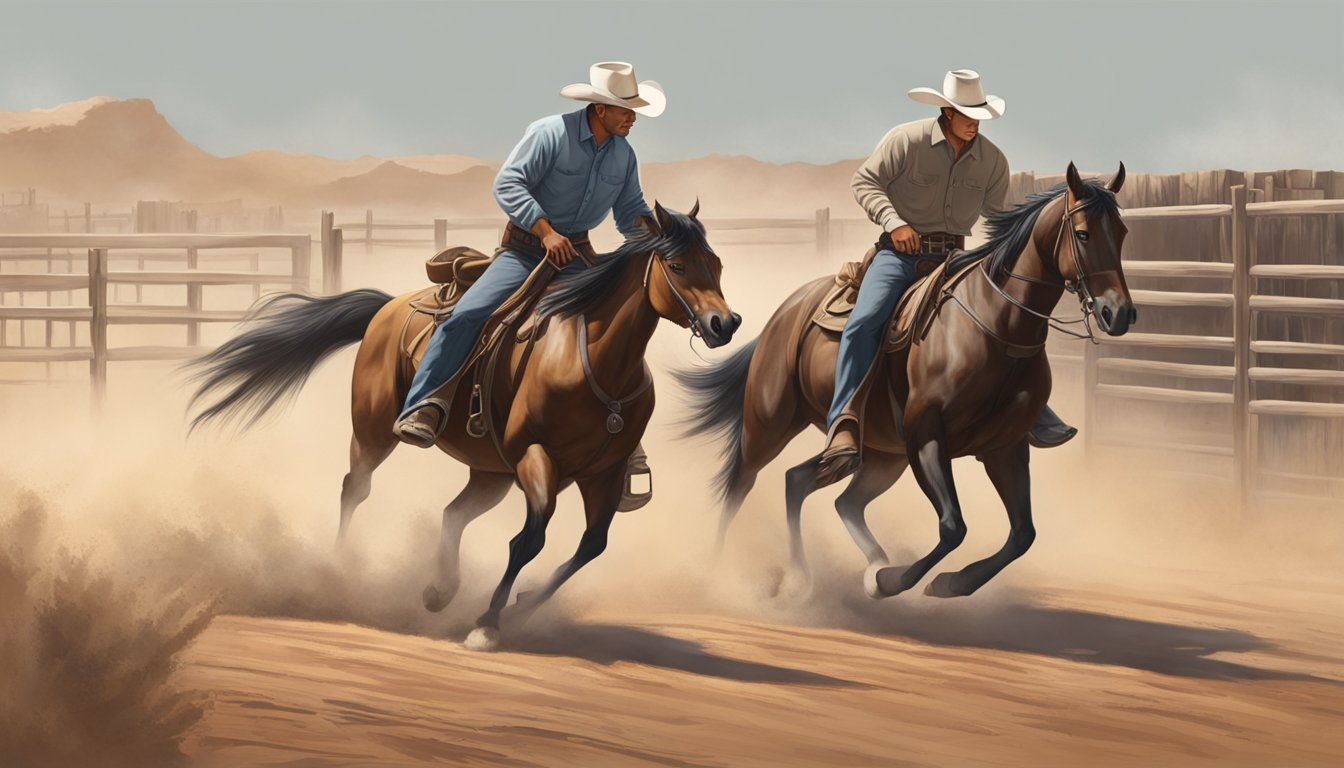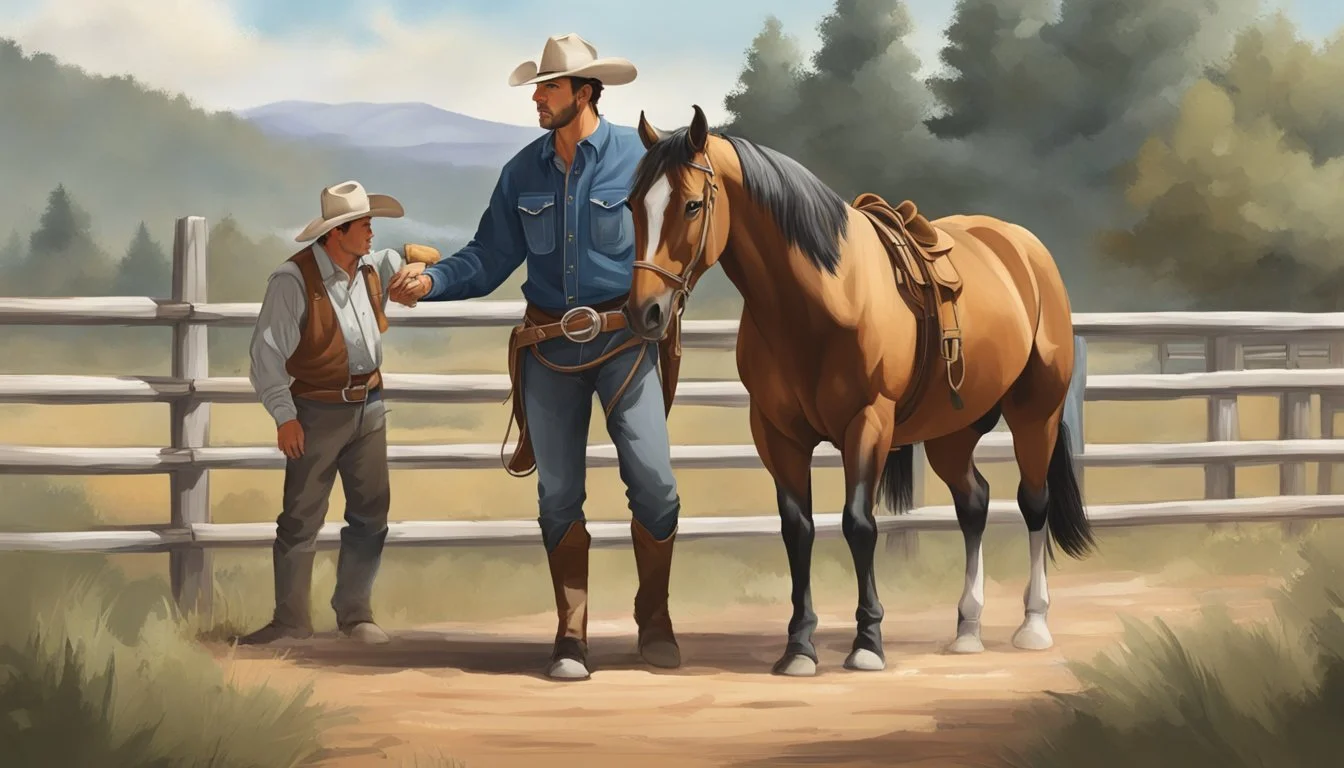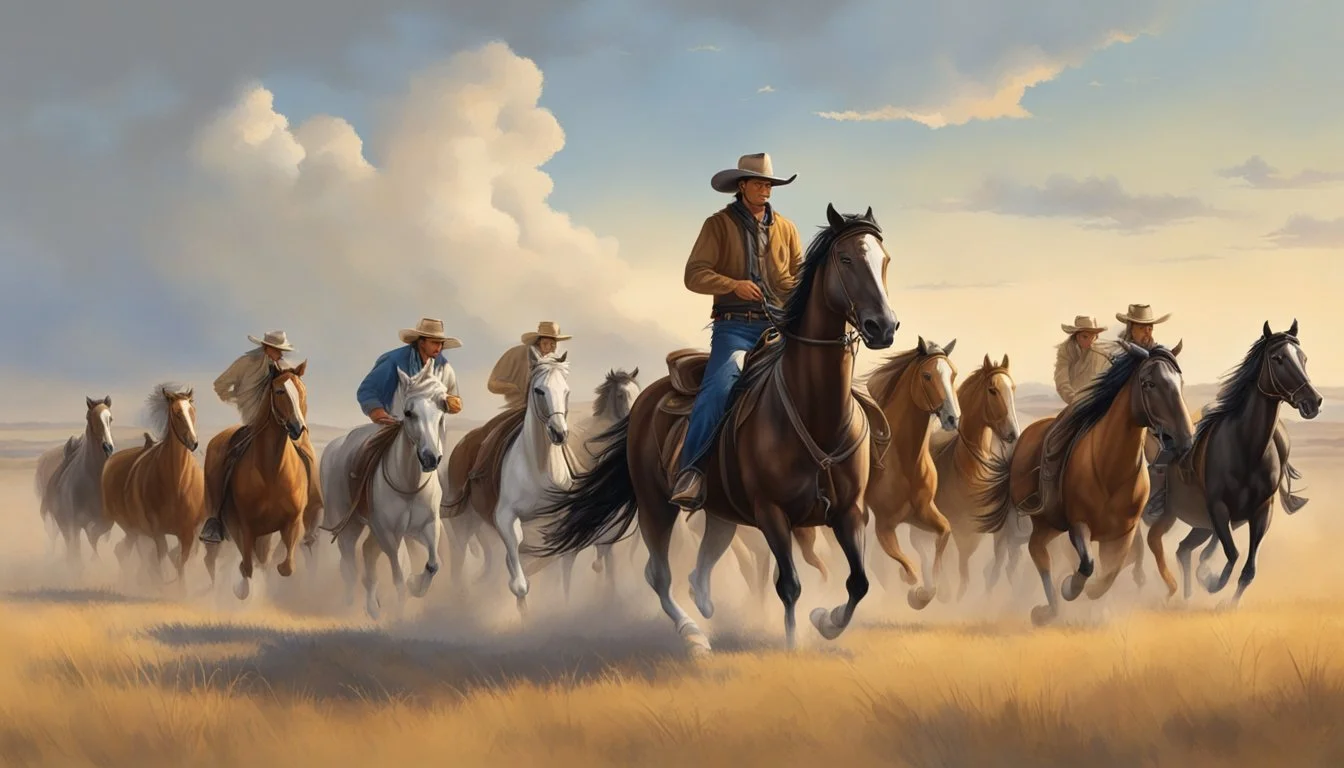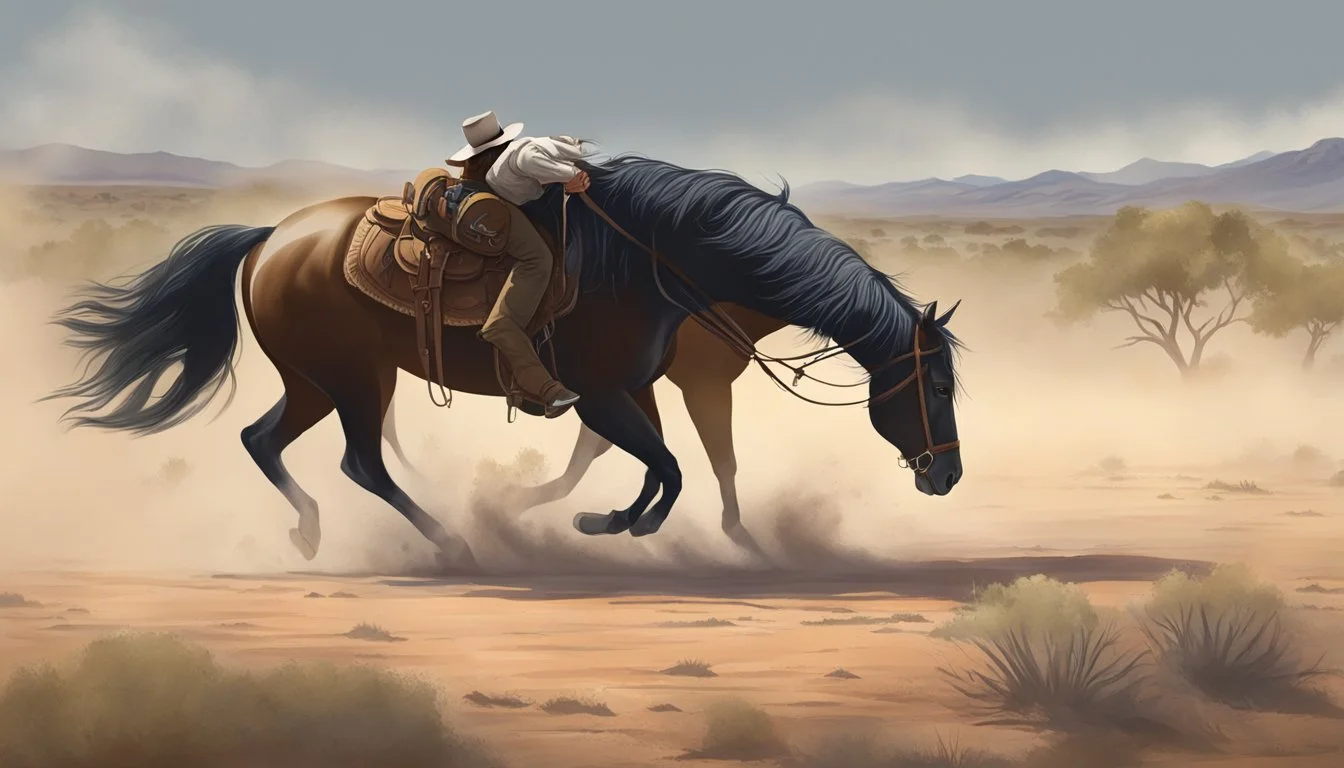The Texas Cowboy's Approach to Horse Breeding and Training
Proven Techniques for Superior Results
The Texas cowboy has an enduring reputation as a skilled horseman, with a deep understanding of equine care and training that has been honed over generations. In the expansive pastures of Texas, horse breeding and training are not merely vocational pursuits but cultural cornerstones that underscore the identity of the region. Working on some of the oldest and largest ranches such as the King Ranch, Texas cowboys have developed specialized techniques that contribute to the success of their equine programs.
A profound respect for the horse is at the core of the Texas cowboy’s approach to breeding and training. This esteem is evident in the careful selection of breeding stock, the meticulous management of broodmares, and the thoughtful training of young horses. The Texas Thoroughbred Breeders' Association and breeding operations focusing on Quarter Horses are testament to the sophisticated level of equine knowledge present within the state.
Breeding programs in Texas are designed to produce horses that showcase the strength, speed, and intelligence required to work the sprawling ranches typical of the Lone Star State. Training methods employed are a blend of traditional cowboy wisdom and modern horsemanship, a duel focus that ensures horses are versatile, reliable, and responsive partners. The Texas cowboy’s approach to horsemanship is a revered and effective tradition, reflecting the spirit and heritage of the state itself.
History of the Texas Cowboy
The Texas cowboy, a cornerstone of American history, has its roots in the practices brought by Spanish explorers, refined through the expansion of the cattle industry, and epitomized during the era of open range ranching.
Origins and Influence of Vaqueros
Vaqueros, the first cowhands in North America, were adept horsemen from Mexico, originally the Spanish territory of New Spain. Their skills in cattle herding became the foundation for the cowboy traditions of Texas. Spanish explorers introduced livestock, influencing local practices and birthing the vaquero culture that would feed into the cowboy way of life.
Expansion of Cattle Industry in North America
Post-Civil War, the demand for beef in Northern states catalyzed the expansion of the cattle industry. Texas, with its large herds of cattle, became a hub for this industry. Ranchers drove thousands of cattle along trails to railheads in Kansas, marking the birth of cattle drives.
Cowboy Life and Culture Post-Civil War
After the Civil War, many Texans turned to cowboying for employment. Cowboys drove cattle across the open range, faced harsh conditions, and adapted to a lifestyle with a strong sense of camaraderie. Their life was one of hard work with long hours in the saddle, essential for herding cattle over vast distances.
Evolution From Open Range to Modern Ranching
With the introduction of barbed wire in the late 19th century, the open range era came to an end, leading to the modern ranch structure. Fencing led to managed herding and breeding programs. Over time, ranchers became more akin to business entrepreneurs, focusing on efficient horse breeding and training, which were critical for maintaining a successful ranch.
Breeding Practices
Horse breeding in Texas is a dynamic blend of tradition and science. Breeders prioritize strong genetics, carefully curated herds, and the time-honored role of the American Quarter Horse.
Understanding Horse Genetics
Breeding horses with success starts with genetics. Texas cowboys and breeders emphasize the importance of proven bloodlines to cultivate traits that are valuable both in ranch work and competitive arenas. They select stallions and mares based on their genetic profiles to pass desired characteristics such as speed, agility, and temperament to their offspring. Matching these traits carefully is pivotal to enhancing the breed's quality and performance.
The Remuda: Building a Quality Herd
The remuda, a Spanish term for a group of working horses on a ranch, is the cornerstone of a cowboy's daily operation. Texas breeders focus on creating a remuda that comprises well-trained, versatile horses. The process involves thoughtful pairing of mares and stallions to produce a lineage of quarter horses known for their superior abilities in handling cattle and performing varied ranch tasks. Each horse is an investment, and a quality remuda is a testament to a ranch's breeding practices.
Role of the Quarter Horse in Cowboy Culture
The American Quarter Horse is synonymous with the cowboy way of life. In Texas, these horses are not just valuable assets but are also part of the state's cultural heritage. Many ranches specialize in breeding Quarter Horses, which excel in short-distance sprinting, a trait historically essential to wrangling cattle. This breed's intelligence and even temperament make it ideal for the multifaceted challenges of ranch work. Breeders uphold these characteristics to maintain the breed's reputation and utility in cowboy culture.
Foundations of Horse Training for Ranch Work
In Texas, a cowboy's partnership with his horse is fundamental to the success of ranch work. Training encompasses establishing a mutual trust for safety, teaching basic commands, and honing a horse's natural instincts for working cattle.
Establishing Trust and Safety
Before a cowboy can effectively work with a horse, they must cultivate a relationship grounded in trust. This is critical not only for performance but also for both the cowboy and the horse's safety. Training begins with getting the horse comfortable with human presence and touch. Cowboys often use a technique known as "sacking out," which involves gently introducing the horse to different stimuli and rewarding calm behaviour.
Sacking out: Gently introduce new stimuli
Objective: Develop trust and desensitize to fears
Introduction to Basic Commands
Once trust is established, the next step involves introducing the horse to basic commands including stop, go, turn, and back up. These commands are imparted through consistent cues that are both verbal and through body language. Reinforcement of these commands is crucial to develop a reliable horse that responds appropriately to a cowboy's directive.
Commands:
Stop: "Whoa" with a pull back on the reins
Go: Light tap on the hindquarters
Turn: Direct rein pressure toward desired direction
Back up: Rein pressure accompanied by a voice command
Developing Cow Sense and Responsiveness
Cow sense—a natural instinct to anticipate and react to cattle—is a valued trait in a ranch horse. Cowboys encourage this trait by exposing horses to cattle early in the training process, helping them learn to read and respond to the animals' movements. Simultaneously, they work on the horse's responsiveness to make sure cues are met with immediate and correct actions.
Cow sense training:
Introduce horse to cattle in a controlled environment
Encourage following and anticipating cattle movement
By incorporating traditional methods and prioritizing these foundational skills, Texas cowboys produce horses that are not just animals, but true partners in ranch work.
Ranching Operations
Ranching operations in Texas involve a complex array of tasks that ensure the effective management of livestock and the sustainability of the ranching lifestyle. This includes the day-to-day responsibilities of ranching life, the intricate process of cattle herding and management, the skillful application of roping techniques, and the use of branding to mark livestock for identification.
Ranching Responsibilities and Daily Life
Every day on a Texas ranch starts with the sunrise and ends long after sunset. A rancher's responsibilities are varied, revolving around the maintenance and care of the ranch's livestock and infrastructure. Essential tasks include feeding and inspecting cattle, maintaining fences and water supplies, and managing the wellbeing of horses essential for daily operations. The daily life is guided by a hands-on approach and a commitment to the health of the animals and the land.
Cattle Herding and Management
Efficient cattle management is the cornerstone of a thriving ranch. Ranchers must understand bovine behavior and use it to their advantage during herding operations, ensuring minimal stress for the animals. Activities include:
Monitoring cattle health: Keeping an eye on the physical condition of the herd to prevent disease.
Pasture rotation: Strategically moving cattle between pastures to manage land resources.
Roping Techniques
Roping is a skill that takes years to master and is integral to various ranching tasks. Ranchers must be adept with a rope for activities like catching strays or administering medical treatment. They rely on several types of roping such as:
Tie-down roping: Also known as calf roping; involves roping a calf by its neck, dismounting, and tying three of its legs together.
Team roping: Involves two riders; one ropes the head while the other ropes the hind legs of the steer.
Branding and Marking Livestock
Branding, a tradition with deep historical roots, remains an important method for identifying cattle ownership. Ranchers heat a metal branding iron to mark the livestock with a unique symbol. Key steps in the process involve:
Designing a brand: Creating a distinct and legally registered mark.
Applying the brand: Using the heated iron to mark the animal in a specific, consistent location.
Ranchers also often use other methods such as ear tags for additional means of identification. Every aspect of ranching operations is performed with a high level of consideration for animal welfare and sustainability.
Life of a Cowboy
In the life of a Texas cowboy, mastery over horse breeding and training is just as important as showcasing their skills. They engage in activities like rodeos and cattle drives that embody their expertise and deep-rooted traditions.
Rodeos: Competition and Skill Display
At rodeos, cowboys demonstrate their riding and roping skills in a competitive arena. These events test their agility, strength, and training techniques, with each cowboy aiming to outperform his peers through events like barrel racing, bull riding, and steer wrestling.
Barrel Racing: Demands precise riding as cowboys navigate their horses in a cloverleaf pattern around barrels at breakneck speeds.
Bull Riding: Showcases a cowboy's courage and balance as he strives to stay atop a bucking bull for eight seconds.
Steer Wrestling: Requires a combination of speed and technique, as the cowboy must dismount his galloping horse to catch and wrestle a steer to the ground.
Cowboys spend countless hours perfecting their skills for these competitions, which are a source of pride and a testament to their life's work.
Cattle Drives: The Art of Moving Cattle
During cattle drives, cowboys employ their knowledge of horse breeding and training to effectively move herds of cattle over long distances, often through difficult terrain. This is where their day-to-day mastery is put to practical use.
Navigation Skills: Cowboys are adept at charting courses that ensure the safety and efficiency of cattle movement.
Herding Techniques: Encompass coordination amongst the cowboys to maneuver the herd, often using specific calls and signals to communicate.
Sustainment: They manage the well-being of both the cattle and their horses, which includes routine feeding and addressing any health issues along the way.
Trail drives accentuate the importance of teamwork among cowboys, as they rely on each other to fulfill the drive's objectives while facing environmental and wildlife challenges.
Influences and Contributions
In the tapestry of Texan heritage, horse breeding and training were shaped by various elements, from wildlife interactions to cultural exchanges and environmental stewardship. The Texas cowboy's approach encapsulates a history of adaptation and skill in the delicate equilibrium of the equine industry.
The Cowboy-Buffalo Relationship
The historical narrative of cowboys in Texas is incomplete without acknowledging the buffalo. Once abundant, buffalo influenced the training of horses for the cowboys' requirements in herding and managing livestock. Cowboys learned to breed and train horses that could navigate the vast grasslands, which were once the domain of large buffalo herds. This interaction facilitated the development of horses with endurance and agility, key traits for navigating the difficult terrain and fulfilling the demand for skilled herding.
Native American Interactions
Native American horsemanship played a foundational role in the heritage of Texas cowboy culture. Direct interactions with Native Americans introduced cowboys to indigenous methods of horse training and selective breeding. Native tribes, renowned for their adept equine skills, exchanged knowledge with cowboys, influencing ranch operation strategies and contributing to the diversification of horse breeds across Texan pastures. Horses were bred to be versatile in their abilities, reflecting the comprehensive understanding of indigenous people regarding local ecology.
Ranching's Impact on Ecology and Grasslands
Ranches in Texas were and continue to be pivotal in shaping the regional ecology and grasslands. Strategic breeding practices involved selecting horses that could sustain the health of native grass species by preventing overgrazing. Ranchers played a crucial role in grassland conservation, ensuring that their livestock upkeep contributed to maintaining the ecological balance. The introduction of pastures and rotational grazing practices helped to protect native grasslands, demonstrating the cowboy's influence on local ecosystems.
Modern Innovations in Horse Breeding and Training
In the realm of equine breeding and training, recent advancements have revolutionized traditional methods with a significant push towards technology and science-based practices.
Technological Advances and Equipment
The landscape of horse breeding has seen profound changes with the integration of genetic selection tools and reproductive technologies. Breeders now have access to sophisticated equipment and computer programs that analyze genetic markers to predict health and performance traits. Technologies such as artificial insemination, embryo transfer, and oocyte and embryo manipulation have become commonplace, ensuring the proliferation of desired characteristics while maintaining genetic diversity.
In training, motion sensors and performance tracking software have emerged. These tools attach to a horse's girth, measuring movement, speed, stride length, and jump trajectory. Such data is invaluable for trainers aiming to fine-tune a horse's performance with precision, contributing to a more efficient, scientific, and welfare-centric approach to training.
Professional Development and Educational Resources
Complementing technological strides, the industry has noted a surge in professional development opportunities. Educational resources, often powered by e-learning platforms, have made advanced knowledge in equine management and training more accessible. There's a wealth of information available online, from tutorials on leather care for saddles and bridles to comprehensive courses on equine nutrition, physiology, and behavior.
Professionals can stay updated with best practices through webinars, virtual conferences, and collaborative projects. This convergence of traditional cowboy wisdom with ongoing education fosters a culture among horse breeders and trainers that is grounded in respect for the past but fully engaged with the modern innovations shaping the future of equine care.
Challenges in Contemporary Cowboy Lifestyle
The modern Texas cowboy faces a diverse array of challenges, from the evolution of ranching landscapes to the fluctuating economy impacting cattle prices. They strive to maintain their cultural heritage while adapting to contemporary demands.
Changing Ranching Landscapes and Fences
As urban expansion continues, sprawling cities and networks of roads encroach upon traditional ranching land. Cowboys must contend with reduced grazing areas and the challenge of maintaining fences alongside growing infrastructure. Fences represent not only physical barriers for cattle but also mark the shrinking territories available for traditional ranching practices. Land development often leads to fragmented habitats requiring cowboys to adapt their livestock management strategies.
Economic Pressures and Cattle Prices
Today's cowboys navigate through economic pressures that directly influence their livelihood. The volatility of cattle prices can strain the financial stability of ranching operations. Fluctuating market demands, feed costs, and the availability of affordable land all weigh heavily on ranch profits. The economic realities compel cowboys to balance traditional practices with cost-effective business models, requiring constant vigilance and adaptation to market trends.
Cultural Preservation and Legacy
Cowboys bear the responsibility of cultural preservation, upholding the legacy of Texas ranching amidst a world of rapid change. They are living symbols of a rich past, tasked with maintaining cowboy culture in a society that often overlooks the importance of agricultural roots. This includes preserving the skills and knowledge of horse breeding and training, which are critical to their way of life. As they safeguard these traditions, cowboys also face the challenge of integrating new practices that ensure the sustainability of their heritage for future generations.
The Texas Cowboy in Popular Culture
The Texas cowboy has become a symbol of American frontier history, immortalized through various mediums of popular culture, including literature, film, and festivals celebrating the storied legacy of the West Texas region. This embodiment of the Wild West is recognized globally for its distinctive iconography.
Representation in Literature and Film
In literature and film, the Texas cowboy is often depicted as a rugged, self-reliant figure. Western novels and cinema have embraced the image of cowboys from West Texas, portraying them herding cattle across the expansive landscapes. Directors like John Ford have cemented the cowboy's place in cinema with films that showcase the unforgiving, yet majestic environment of the Wild West. Classic works, such as "Lonesome Dove," a novel-turned-miniseries, have contributed to the romanticized vision of the cowboy's adventurous life.
Cowboy Iconography and Festivals
Iconography associated with the Texas cowboy is recognizable by cowboy hats, boots, and spurs. These items hold cultural significance and are emblematic of the cowboy's trade. Festivals, such as the Houston Livestock Show and Rodeo, continue to venerate cowboy culture with events that include rodeo competitions, cattle shows, and country music performances, drawing visitors from around the world.
Global Perception of the Texas Cowboy
Globally, the perception of the Texas cowboy has been shaped by a mixture of historical accounts and popular culture representations. This image has been exported worldwide through movies and television, establishing the Texas cowboy as an international icon of American culture. Their representation in media has made the cowboy synonymous with themes of bravery, independence, and a connection to the land, resonating with audiences far beyond the borders of Texas.










